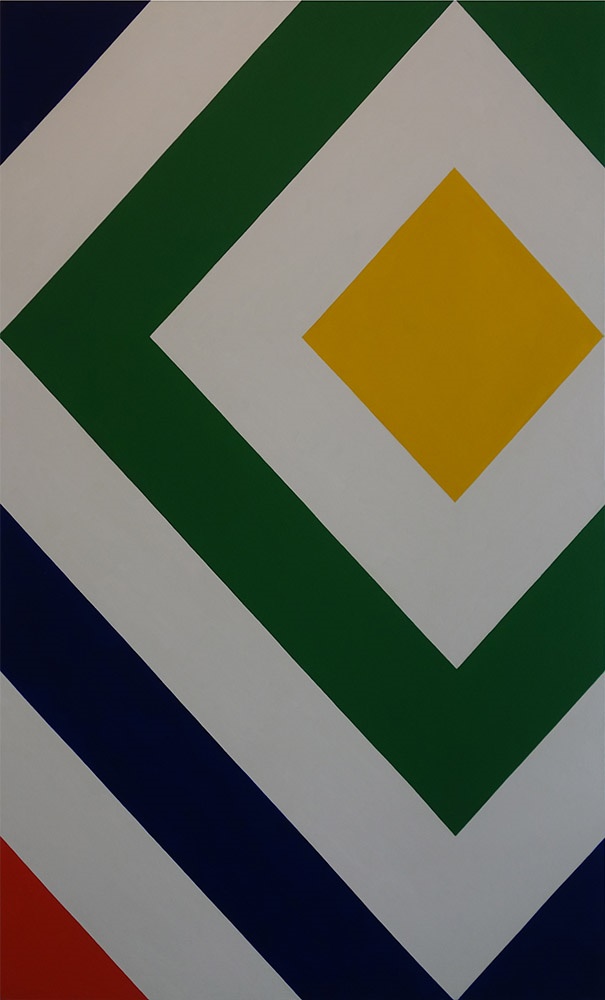Stephen Westfall’s optimism is on view. The twelve paintings in this exhibition radiate freedom and joy. He continues to mine the possibilities of harlequin patterned diamonds in bold colors, both contrasting and close-valued. Underlying grids are skewed or absent, or present if that is his preference. There are ringers, though, compositions perfectly new, which might slyly reference precedents from past paintings or derive from something as casual as a phone photo of one painting leaning against another in the studio. We viewers don’t need to know the genetic makeup of each painting, just to enjoy them as they are.
Artists:
Stephen Westfall
Available:
September 14, 2018 -
October 27, 2018
About:
Stephen Westfall’s optimism is on view. The twelve paintings in this exhibition radiate freedom and joy. He continues to mine the possibilities of harlequin patterned diamonds in bold colors, both contrasting and close-valued. Underlying grids are skewed or absent, or present if that is his prefer...
more >>
Stephen Westfall’s optimism is on view. The twelve paintings in this exhibition radiate freedom and joy. He continues to mine the possibilities of harlequin patterned diamonds in bold colors, both contrasting and close-valued. Underlying grids are skewed or absent, or present if that is his preference. There are ringers, though, compositions perfectly new, which might slyly reference precedents from past paintings or derive from something as casual as a phone photo of one painting leaning against another in the studio. We viewers don’t need to know the genetic makeup of each painting, just to enjoy them as they are. The Arts and Design program of the MTA, New York State’s subway authority, commissioned three works from Westfall for a station renovation at the 30th Avenue stop in Astoria, Queens. Perasma I and Perasma II, each more than sixty feet long, are first seen from the street suspended over an intersection, then inside spanning the length of the station mezzanine on both sides. Executed in laminated glass, they transform and transmit the light of day into a formerly dark interior and, at night, project like beacons over the street. A third mural, Dappelganger, presides over a seating area but also glows as the jewel it was designed to be when seen from under the tracks. Westfall has covered a lot of territory in the realm of hard-edge geometric abstraction since he first showed with Lennon, Weinberg in 1997, when his work featured subtly destabilized layered grids over modulated field colors. Diagonals appeared before long, and by the time he returned from a fellowship at the American Academy in Rome in 2010, they had supplanted rectilinear structures while still adhering to defined systems. Now his painted space might tilt and veer or snap to edge and surface, his colors are synthetic and activated. He is making music – a harmony here, a dissonance there, and a grand finale in the three newest paintings in the show, the trio of six-foot vertical paintings, Wild Card, Sorcerer and Jubilee. The titles alone speak volumes about what Westfall has going on. The paintings themselves rank with the best he has ever made. Stephen Westfall (b. 1953) received his MFA in 1978 from the University of California, Santa Barbara. His first solo show was at Tracey Garet in New York’s East Village in 1984. Exhibitions followed during the 1980s and 90s at Daniel Newburg Gallery, New York; Galerie Paal, Munich, Germany; Galerie Wilma Lock, St. Gallen, Switzerland; Andre Emmerich Gallery, New York; and Galerie Zurcher, Paris, France. Westfall has been represented by Lennon, Weinberg since 1997 and has had eight exhibitions at their locations in Soho and Chelsea in New York. He had his first show with David Richard Gallery in Santa Fe, New Mexico in 2015 and has recently collaborated with Polly Apfelbaum on exhibitions presented at Clement & Schneider in Bonn, Germany in 2014 and at The Suburban in Milwaukee, Wisconsin in 2015, where he showed rugs recently woven under his direction in Oaxaca, Mexico. Westfall’s work has been included in several important thematic exhibitions of abstract paintings, including Conceptual Abstraction at the Hunter College Art Gallery in 2012. Survey exhibitions of his work were presented at Colgate University in 2000 and Western Carolina University in 1999. He installed his first monumental wall paintings at Solvent Space in Richmond, Virginia in 2007, followed by others at the American Academy in Rome in 2010, and a permanent work installed at the Mason Gross Performing Arts Center at Rutgers University in New Brunswick, New Jersey in 2014. An exhibition at Art OMI in 2014 featured two very large wall paintings. He was commissioned by the Museum of Art, Architecture and Design at the University of California Santa Barbara in 2015 to create a permanent outdoor wall painting and a second large work for the museum’s Nachman Gallery. A wall painting installation in the AT&T Lobby at the McNay Art Museum in San Antonio, Texas remains on view through July 2016. Works by the artist are in the collections of the Whitney Museum of American Art in New York, the Kemper Museum in Kansas City, the Louisiana Museum in Humlebaek, Denmark, the Munson Williams Proctor Museum in Utica, New York, the Baltimore Museum of Art, the Museum of Fine Arts, Boston and the UBS Art Collection. Westfall has received grants and awards from the National Endowment for the Arts, the American Academy of Arts and Letters, the Nancy Graves Foundation, and the Guggenheim Foundation. He received a Rome Prize Fellowship and spent a year at the American Academy in Rome during 2009 and 2010. He is a professor at the Mason Gross School of the Arts at Rutgers University and in the graduate program at Bard University. He is a Contributing Editor at Art in America.






